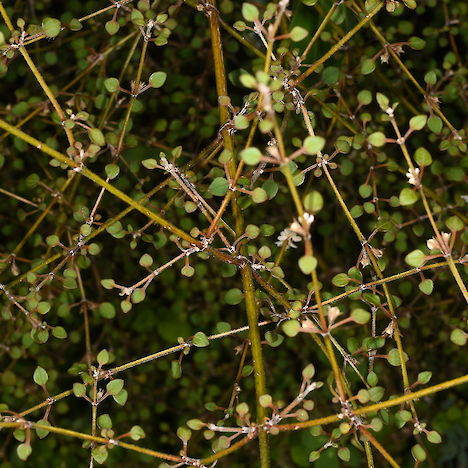Threat category:
At Risk: Declining?Regions:
Northland, Auckland, Waikato, Bay of Plenty, Gisborne, Hawkes Bay, Manawatu-Wanganui, Taranaki, Wellington, Nelson-Tasman, Marlborough, Canterbury, Otago, SouthlandDistribution:
North Island and South Island
Key Features
- A straggling shrub to 1.5 m, with red-brown branchlets that are square in cross section.
- The small, thin, dull-green, spoon-shaped leaves are up to 2 cm long (including the stalk) and occur in opposite pairs along the branchlets.
- Flowers are white with irregularly shaped petals that drop off to leave the four dry seeds cupped within the persistent, 5-pointed calyx.
- The small opposite leaves make this species superficially similar to small-leaved species of Coprosma and rohutu (Neomyrtus pedunculata), but both of these have fleshy fruits, and species of Coprosma have branches that are round in cross-section.
Distribution and Habitat
- North and South Islands, from Northland to Southland, mostly in eastern areas in the South Island.
- Habitat is dry, usually open lowland forest.
Threats
- Habitat modification and loss.
- Stock and feral animal browse.
- Competition with weeds.
Management Opportunities
- Survey for new locations.
- Mark known sites.
- Protection of habitat.
- Exclude stock and control feral animals.
- Control shrubby weeds encroaching on sites.
- Ensure that forest owners are aware of potential habitats and can recognise the species.
Monitoring Options
- Check existing populations annually.
- Report new locations to DOC, NZPCN.
Further Information and Support
- New Zealand Plant Conservation Network (NZPCN). http://www.nzpcn.org.nz
- Pest and weed control – Department of Conservation, Regional Councils
- References:
- Poole & Adams (1994). Trees and shrubs of New Zealand. Maanaki Whenua Press, Lincoln.
- Wilson & Galloway (1993). Small-leaved shrubs of New Zealand. Manuka Press, Christchurch.





